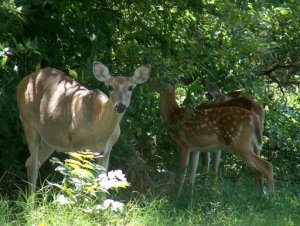Gene Howe WMA
Phone: (806) 323-8642
Contact:
Brody Larkin
Dates Open:
Open year-round, except entire area closed for special hunts
Description
The Gene Howe Wildlife Management Area (GHWMA) 5,394 acres located along the Canadian River in the Northern Rolling Plains of Hemphill County. Using Pittman-Robertson funds Texas Parks and Wildlife Department purchased the first parcels in 1950 and 1951 for the purposes of wildlife management, public use, and research.
The GHWMA is comprised of roughly two-thirds sand sagebrush/midgrass rangeland and one-third cottonwood/tallgrass bottomland. Common plant species in the sand sagebrush/midgrass habitat include sand sagebrush, sand plum, fragrant sumac, little bluestem, sand bluestem, and blue grama. Dominant plants found in the cottonwood/tallgrass habitat include eastern cottonwood, netleaf hackberry, black locust, American elm, roughleaf dogwood, big bluestem, switchgrass, Indiangrass, and alkali sacaton. Numerous wildlife species occur on the GHWMA, including bobwhite quail, Rio Grande turkey, white-tailed deer, mule deer, coyote, bobcat, black-tailed jackrabbit, raccoon, eastern cottontail, black-tailed prairie dog, feral hog, burrowing owl, Mississippi kite, Texas horned lizard, mourning dove, prairie rattlesnake, and western massasauga rattlesnake. The aquatic wildlife is plentiful as well, with species like largemouth bass, black crappie, channel catfish, bluegill and various other sunfish species including hybrids, spotted gar, common carp, and various aquatic herps.
Public use opportunities on the Gene Howe WMA fall into three categories. The first category is our Limited Use program. With the purchase of a Limited Use permit, you can enjoy fishing, hiking, camping, and bird/wildlife watching. Second is our Annual Public Hunting program. With the purchase of an Annual Public Hunting Permit, you can enjoy all items in the limited use category plus hunting opportunities for mourning dove, various waterfowl, and northern bobwhite quail during the WMA-approved hunting seasons. The third and final category is our Drawn Hunts opportunities. Drawn Hunts on the WMA include multiple big game and upland species such as white-tailed deer, mule deer, feral hog, and Rio Grande turkey. These hunts are run through the Texas Parks and Wildlife Department's drawn hunt system. There are a multitude of opportunities to enjoy this oasis on the plains.
Students, teachers, and scientists use the GHWMA for instructional, educational, and research purposes. Do not disturb any markings, flags, traps, etc. that you encounter, as this may affect results.
- Hunting of certain game species such as white-tailed deer, mule deer, feral hog, and Rio Grande turkey are Draw Only!
- Everyone must Sign In at the Gene Howe WMA check station before entering the WMA. The check station is located at the Gene Howe WMA Headquarters.
- Camping is Primative. Bring your own water.
- Not wheelchair accessible.
